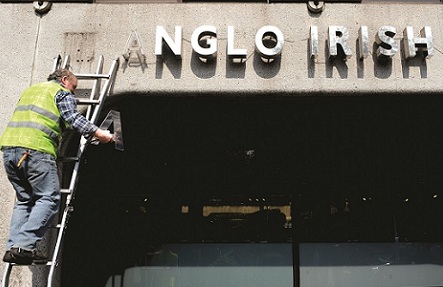

On 20 April 2011 a small crowd gathered at St Stephen’s Green in Dublin to watch this sign being taken down outside the headquarters of Anglo Irish Bank. They gave a ‘small cheer’ as it was dismantled. When the sign had been erected over a decade earlier, its design drew on iconic objects of Ireland’s past:
Based on early Irish references such as flint arrowheads, typography from the Book of Kells and crafted gold artefacts, the simplicity of the image sets the tone for a more cohesive corporate identity programme and spearheads measurable improvement in brand awareness.
By the time the sign was removed, Anglo Irish had certainly achieved a very high level of brand awareness—as one of the most notorious banks in world history. It was founded in 1964, but by 1987, its first full year as a publicly quoted company, it had loans of just £92 million and profits of just £1.45 million. At its height in 2007 Anglo was theoretically valued at over €10 billion; its annual profits hit €1.2 billion. Most of that growth was concentrated in the first seven years of the twenty-first century, during which its share price rose by 2000 per cent. Over 80 per cent of its loans—it lent a staggering €18 billion in 2007 —were related to property. The bank epitomised the vast Irish property bubble that burst with ruinous consequences in 2008.
The Irish economy had begun to grow rapidly from 1995. The expansion of world trade following the collapse of the Soviet Union and the opening up of China; the boom in information technology; a young and increasingly well-educated population; favourable tax rates that continued to attract multinational corporations; and social changes creating a huge increase in the number of women in the workforce—all were factors in a surge of prosperity.
The value of Irish exports more than doubled between 1995 and 2000. Unemployment halved in the course of the decade, while Gross Domestic Product per head of population rose from three-quarters of the European Union average to 111 per cent. Mass emigration was replaced by a remarkable wave of inward migration from central and eastern Europe, Africa and elsewhere. Ireland became the great success story of economic globalisation.
In reality, the real Irish boom had ended by 2003 and was replaced by a frenzy of investment in property. Ireland’s membership of Europe’s new currency, the euro, which came into circulation on 1 January 2002, made credit cheap and easily available. This credit, most of which came ultimately from banks in Germany, France and Britain, was mainly spent on property: bank lending for construction increased between 1999 and 2007 from €5.5 billion to €96.2 billion. When the house of cards collapsed in 2008, Anglo was nationalised and eventually wound up, leaving Irish citizens with a bill of around €29 billion and an expensive lesson in the need to remember history.